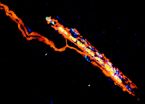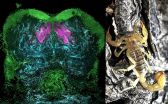(Press-News.org) TORONTO -- Very small segments of genes called "microexons" influence how proteins interact with each other in the nervous system, scientists at the University of Toronto have found, opening up a new line of research into the cause of autism.
The researchers found that microexons are used in neurons by alternative splicing, a process in which a single gene can produce many different proteins. Microexons are pasted -- or spliced -- into gene messengers (mRNAs) to generate forms of proteins that the nervous system needs to function properly. Misregulation of this process, the researchers found, can have major effects on how proteins function.
"We're seeing a new landscape of splicing regulation that is highly specific to the nervous system, and which is very important for controlling how proteins interact with each other," said Benjamin Blencowe, a Professor in the University of Toronto's Donnelly Centre for Cellular and Biomolecular Research and Department of Molecular Genetics. "In addition, a large number of the microexons we detected show misregulation in people with autism."
Scientists -- including Blencowe and his colleagues at U of T -- previously created algorithms to predict which exons are spliced in mRNAs to produce proteins. But these algorithms failed to capture microexons.
In their new study, Blencowe and his colleagues, led by postdoctoral fellow Manuel Irimia, created a new computational tool that detects many more splicing combinations within a cell, including those that involve microexons. They used their tool to discover splicing of microexons in neurons.
The leading biomedical research journal Cell published the findings.
"We were really surprised to find that some microexons encode just 1 or 2 amino acids -- the basic building blocks of proteins," said Irimia, who recently took a position as a junior group leader at the Centre for Genomic Regulation in Barcelona, Spain, where he is setting up his own lab. "And they modify proteins -- changing their surface structures -- in ways that longer exons cannot. Microexons perform a type of microsurgery on proteins to alter their function."
The researchers also found that neuronal microexons are highly conserved during evolution, which strongly suggests they play conserved functional roles. They discovered the existence of similar microexons in many vertebrate species, including mice and humans.
Perhaps most importantly, the researchers also found that even though microexons make very small changes to proteins, the effects of those changes can be dramatic. For example, when they deleted microexons they found that in some cases proteins completely lost their ability to interact with partner proteins.
As well, the group found that many neuronal microexons are weakly spliced in the brains of some individuals with autism, and that this reduced splicing activity is linked to the under-expression of a splicing regulatory protein called nSR100. Blencowe is cautiously optimistic about the potential therapeutic value of this discovery. "While a lot more work has to be done to understand the functions of microexons in the nervous system, we were amazed by the extent to which microexons are misregulated in people with autism, which suggests they are an important component of this neurological disorder."
Blencowe and his colleagues are pursuing the role of nSR100 in autism as they map the function of microexons in more detail. By following this line of research, they hope to learn how the misregulation of microexons contributes to autism as well as other disorders of the nervous system.
"Microexons are an underappreciated class of splicing event that is highly conserved. They change the way proteins interact and clearly play an important role in development, so understanding their role in human neurological disorders represents a major avenue of future research," said Blencowe.
INFORMATION:
RESEARCHERS have discovered the unique genetic paths that the childhood brain tumour medulloblastoma follows when the disease comes back, according to research* published in Cancer Cell today (Thursday).
The study - funded by Cancer Research UK, Action Medical Research and others** - shows that taking an extra tumour sample at recurrence, when there are no effective therapies, could identify subsets of patients that might be treatable with existing drugs that target the genetic faults.
The scientists, based at Newcastle University and The Institute of Cancer Research ...
There are two main families of bacteria : those that are surrounded by a single membrane (or one outer wall) and those that are surrounded by two membranes (or two outer walls). The team of Jean-François Collet, professor at the de Duve Institute at UCL, looked at this second type of bacteria.
For a bacterium to survive, it has to keep its two outer walls intact. If one of these walls is damaged, the bacterium dies. So it was vital for the UCL researchers to analyse the protection mechanisms of these bacterial "walls' (to find their weak spot), so as to be able to ...
This latest research by Joshua Brickman and his research team from Danish Stem Cell Center (Danstem) at the University of Copenhagen specifically found that inhibiting or blocking stem cells ability to make a specific decision, leads to better cell growth and could lead to defined ways to differentiate stem cells.
This research is the first comprehensive analysis of a pathway important for stem and cancer cell decisions known as Erk. As a result this work could contain clues to cancer treatment as well as helping to establish a platform to make stem cell treatments for ...
After an incomplete spinal cord injury, the body can partially recover basic motor function. So-called muscle spindles and associated sensory circuits back to the spinal cord promote the establishment of novel neuronal connections after injury. This circuit-level mechanism behind the process of motor recovery was elucidated by Prof. Silvia Arber's research group at the Biozentrum, University of Basel and the Friedrich Miescher Institute for Biomedical Research. Their findings may contribute to designing novel strategies for treatment after spinal cord injuries and have ...
Walter and Eliza Hall Institute researchers have for the first time revealed how dying cells are hidden from the immune 'police' that patrol the body.
The research answers a decades-old mystery about the death of cells, which in some situations can alert the immune system to potential danger, but in other circumstances occurs 'silently', unnoticed by immune cells.
Silent cell death, or apoptosis, is a controlled way for the body to eliminate cells that may be damaged, old, or surplus to the body's requirements, without causing collateral damage. This 'normal' cell death ...
This news release is available in Spanish. The genome is the cell's book of instructions. All the cells in our body contain the same genomic information but each of them "reads" the gene fragments that interest them in order to carry out their function. So, neurones, hepatocytes and cardiac cells are different although their genome is the same. In order to achieve this huge variety of functions from the same genome, the cells employ a mechanism known as alternative splicing. This enables them to combine several fragments - known as exons - from the same genes in order ...
Mountain View, Calif. - December 18, 2014 - 23andMe, Inc., the leading personal genetics company, today announced the publication of a study that pinpoints fine-scale differences in genetic ancestry of individuals from across the United States.
Since immigrants first arrived more than four hundred years ago, the United States has served as a meeting place for peoples from different continents. This study illuminates how American history and the ongoing mixing of peoples with African, European, and American origins can be seen in our DNA.
"The relationship between genomics ...
HOUSTON - (Dec. 18, 2014) - Cars that run on natural gas are touted as efficient and environmentally friendly, but getting enough gas onboard to make them practical is a hurdle. A new study led by researchers at Rice University promises to help.
Rather than shoehorn bulky high-pressure tanks like those used in buses and trucks into light vehicles, the Department of Energy (DOE) encourages scientists to look at new materials that can store compressed natural gas (CNG) at low pressure and at room temperature. Cage-like synthetic macromolecules called metal organic frameworks ...
LA JOLLA, CA--December 18, 2014--Collaborating scientists from The Scripps Research Institute (TSRI) and the University of California (UC) San Diego have developed a powerful new system for studying how proteins and other biological molecules form and lose their natural folded structures.
Using the new system, researchers can force a sample of molecules to unfold and refold by boosting and then dropping the temperature, so quickly that even some of the fastest molecular folding events can be tracked.
"One way of studying these structures has been to make them unfold ...
Whether you're cramming for an exam or just trying to remember where you put your car keys, learning and memory are critical functions that we constantly employ in daily life.
It turns out that the structure and function of brain centers responsible for learning and memory in a wide range of invertebrate species may possibly share the same fundamental characteristics, according to a new study published in the journal Current Biology and performed by University of Arizona neuroscientists Nicholas Strausfeld, Regents' Professor in the Department of Neuroscience, part of ...




